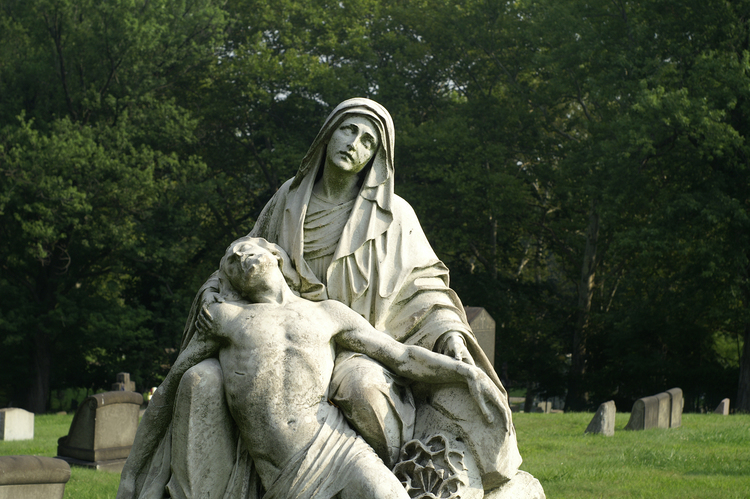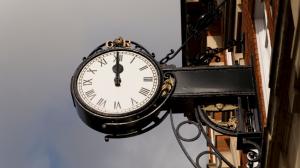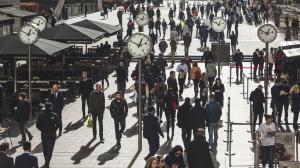
Best Comet of 2025?
C/2024 G3 (ATLAS) has already become very faintly visible to the naked eye for observers in the Southern Hemisphere.
Holy Saturday commemorates the day that Jesus Christ lay in the tomb after his death, according to the Christian bible. It is the day after Good Friday and the day before Easter Sunday. It is also known as Easter Eve, Easter Even, Black Saturday, or the Saturday before Easter.

Holy Saturday commemorates the day that Jesus (sculpture of him pictured above) lay in his tomb after he died. He was resurrected on Easter Sunday, the day after Holy Saturday, according to Christian belief.
©iStockphoto.com/bgwalker
Many Christians worldwide observe Holy Saturday by remembering it as the day when Jesus lay in the tomb. It is a day of both sadness and joy among Christians in many cultures. Many churches hold an Easter vigil (watch) service. Discussions about the meaning behind the rituals, prayer and symbols that are all part of the Easter vigil occur during these services. Some churches also hold large baptism services on this day.
Holy Saturday is known as Judas Day in Mexico, where people burn effigies of Judas Iscariot, who betrayed Jesus for 30 pieces of silver. Street vendors sell the effigies, which range in height, and make Judas look as ugly as possible. Effigies called piñatas designed for children are stuffed with candy and hung in patios at people’s homes. Other effigies are seen on the streets or hung on lamp posts. Firecrackers are attached to many of these effigies and are ignited as soon as the Mass of Glory is over. Children scramble for the candy inside the effigies after they explode.
A Czech custom, known as White Saturday, is to rattle keys and burn out Judas by burning the last of the holy oil before the church door. Holy Saturday is observed by the blessing of food and Easter baskets in Poland. Children in many countries spend time decorating and coloring eggs on the Saturday before Easter Sunday.
Holy Saturday is a public holiday in many parts of Australia (where it is known as Easter Saturday), and in places such as (but not exclusive to):
Holy Saturday is not a national public holiday in countries such as Canada, the United Kingdom, and the United States.
Holy Saturday is the last day of Holy Week and ends the season of Lent. It is also known as the Vigil of Easter. The day is traditionally a time of reflection and waiting. The vigil stems back to when Jesus’ followers spent this day waiting after his crucifixion on Good Friday. It is also known as the day when Roman governor Pontius Pilate instructed guards to be posted at the tomb to prevent Jesus’ followers from removing the body to claim that he had risen from the dead.
Holy Saturday was also known as Great or Grand Saturday, as well as the Angelic Night. It was the only Saturday on which fasting was permitted in the early days of the Christian church. According to some sources, fasting occurred during the entire day or lasted for 40 hours before the Easter Sunday sunrise during the first century CE. This day was a major day for baptisms in the early church. Many churches still hold large services for baptisms on Holy Saturday.
Some people refer to Holy Saturday as Easter Saturday but this is a misnomer, as Holy Saturday is the last day of Lent and the eve of Easter. The Saturday after Easter Sunday is known as Easter Saturday, or Bright Saturday. It is important to note, however, that Holy Saturday is often referred to as Easter Saturday by some government sources in countries such as Australia.
The Paschal candle, which is made of white wax, symbolizes leading people out of the darkness into the celebration of the Easter vigil. The candle is marked with a cross, an alpha and an omega (the first and last letters of the Greek alphabet). This symbolizes that Jesus Christ has, and always will be with humanity, and is with humanity now, according to Christian belief.

C/2024 G3 (ATLAS) has already become very faintly visible to the naked eye for observers in the Southern Hemisphere.

How does the 12-hour clock system work? Is midnight 12 am or 12 pm?

Why do many countries set the clocks back and forth an hour twice a year?

Why are there 12 months? How long are they, and what do the month names mean?